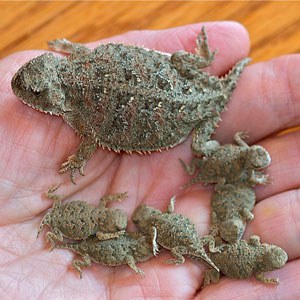Hikers following Central Oregon trails through dry, sandy areas sometimes see tiny, rotund lizards that have a stubby tail and wonder, "What the heck is that odd critter?"
What they've encountered is a reptile that's unique to our region: the pygmy short-horned lizard (Phrynosoma douglasii).
There are twelve to fifteen recognized species of horned lizards native to North America, the tally sometimes differing according to the opinion of the taxonomist consulted. All have a rather bizarre, spiny appearance that causes them to resemble a diminutive dinosaur or dragon. Because of a rather plump body shape, they are sometimes mistakenly called "horned toads", but they're of course not an amphibian. Most kinds have a distinctive crown of relatively long spines at the rear of the head. But as the name implies, the short-horned lizard has mere pointy nubbins on its cranium. And it's truly a pygmy. Most "large" adults are usually only about two to three inches in total length. If any reptile can be considered cute, it's this dinky species.
Because horned lizards usually match the soil and pebbles where they live, their dorsal coloring varies from grayish-tan to reddish-brown, depending upon the geographic area. In fact, unless a pygmy short-horned lizard moves and catches your eye, it'll probably remain overlooked.
Generally, folks think of finding horned lizards in sandy deserts. The pygmy short-horned lizard indeed ranges throughout much of the open, semi-arid sagebrush-juniper country of the Northwest. But it also occurs in sunny clearings among pine woods on the eastern slope of the Cascade Mountains. Surprisingly, populations even manage to survive along the Cascade crest, nearly to timberline at about 7,000-feet elevation.
In September of 2000, longtime friend and fellow naturalist, Jim Anderson and I hiked to the 5,500-foot summit of Sand Mountain in the Santiam Pass area. Just below the fire lookout tower, we found a petite two-inch female pygmy short-horned lizard on the sun-warmed, volcanic pumice-sand. While Jim took his turn snapping close-up photos of the diminutive animal, I surveyed our surroundings of stunted sub-alpine fir, noble fir and whitebark pine, marveling at the spectacular views of lofty, snowcapped peaks. Not the typical sort of place where one expects to find a warmth-requiring, "cold-blooded" (ectothermic) reptile!
Along with the Deschutes Land Trust's Metolius Preserve, other good locations in Central Oregon to observe pygmy short-horned lizards are in the vicinity of Cold Springs Campground west of Sisters, the shrubby sand flats around Tumalo Reservoir, and at Fort Rock State Park, about seventy miles southeast of Bend.
If you're lucky enough to find one of these interesting Northwest endemic lizards, please don't be tempted to bring it back home for a terrarium pet. With their specialized diet of ants, horned lizards of all species do not fare well in captivity and usually die before long. Besides, the Oregon Department of Fish and Wildlife currently lists the pygmy short-horned lizard as protected, so it's against the law to take one from the wild.
Have you ever seen a pygmy short-horned lizard in the wild? Where?
A native Oregonian, Alan D. St. John lives in sage-scented juniper woodlands near Bend with his wife, Jan. Al is a freelance interpretive naturalist who uses writing, photography, and drawings to teach about the natural world. Specializing in herpetology, he has worked as a reptile keeper at Portland's zoological park, and conducted extensive reptile and amphibian field surveys for the Oregon Department of Fish and Wildlife, USDA Forest Service, the U. S. Department of the Interior's Bureau of Land Management, and the National Park Service. Along with authoring the books, Reptiles of the Northwest and Oregon's Dry Side: Exploring East of the Cascade Crest, his work has appeared in National Geographic, Outdoor Photographer, Ranger Rick, Natural History, Country, Nature Conservancy, The New York Times, and other periodicals.


